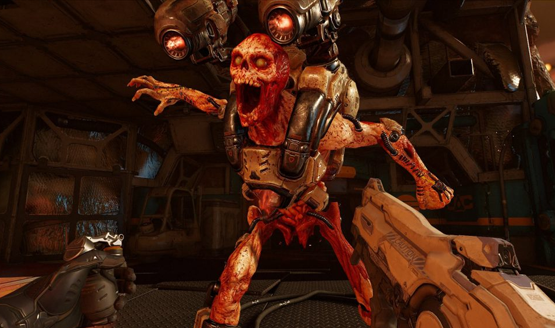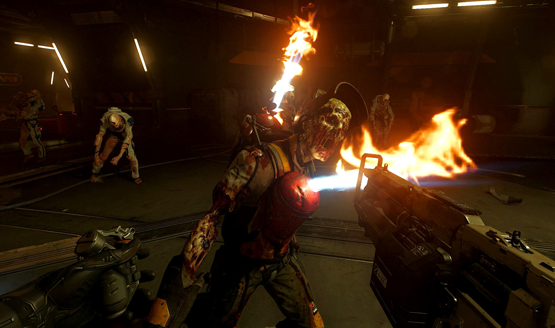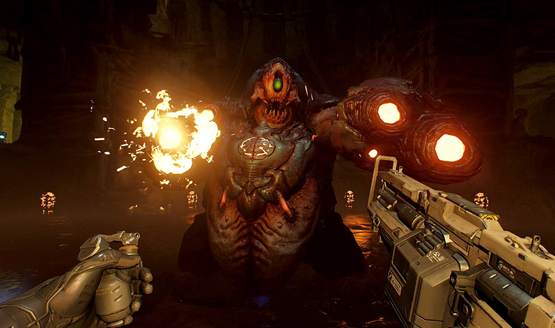Doom has been a violent and bloody gaming staple for 25 years, and fans flocked to the critically acclaimed reboot that came out last year. As fans of virtual reality started thinking about experiences they want on the platform, Doom frequently appeared high on that list. Developers have been consistently impressing with the work they are doing in the headset, and Bethesda has been digging into their back catalog to see if they can leave their mark. Skyrim VR managed to be yet another amazing release of a game whose relevance just won’t go away, and Doom VFR takes the best parts of 2016’s Doom and puts players face-to-face with demons and their bloody insides.
If there’s one thing that’s clear, it’s that Doom VFR is Doom in virtual fucking reality (shame on you if you didn’t know what the F stood for). Bethesda has done an incredible job of recreating the experience of their games in VR, first with Skyrim and now with Doom. Unlike Skyrim, Doom is a wholly new game, instead of porting 2016’s game to virtual reality, and that may have been for the best. It feels tailor-made to the VR experience, instead of trying to make a fast paced shooter where movement is crucial work in the headset.
That’s not to say that Doom VFR isn’t fast paced. It’s quite fast, almost frustratingly so, if some control schemes are to be considered. Teleportation is the main focus of moving about the world, even being written into the story as the main character being uploaded to a mechanical body after being mauled by one of the game’s fearsome creatures. What’s more, weakened enemies can be teleported into with a move called telefragging that causes them to explode and release health orbs. Doom VFR is every bit Doom, pushing PSVR even further and giving Bethesda another win in virtual reality in 2017.
Choose the Aim
Doom VFR works with all three control configurations in PlayStation VR (Aim, Moves, and DualShock 4), but doesn’t feel fully designed for any one of them. Each one feels like there were concessions made in favor of designing around all three and keeping the gameplay relatively the same across the board. By far the best option is the Aim controller, once the option to move with the forward analog stick is turned on. If you can stomach full locomotion in VR, the Aim makes it feel like Doom, flying around each stage and reducing demons to piles of blood and bones. The downside here is that the game is designed with two hands in mind, so there’s always an awkward left hand holding a grenade or launcher stuck to the head tracking. It’s a minor issue, but one that makes it clear Doom was not built from the ground up with Aim controller functionality as its primary focus, which is quite frankly disappointing.
If you take on dual-wielding with the help of the Move controllers, you’ll find that locomotion is completely gone. There are quick dash moves mapped to the face buttons, but in the heat of combat, it was easy to forget which is what direction, as they aren’t laid out like a directional pad on the Move. Teleportation is the primary form of movement, but only allows you to do a full 180 degree turn around, which can be quite disorienting. PSVR is not built for room-scale, yet while trying to use the moves and their lack of incremental turning, I found that I was constantly facing the wrong direction and losing tracking on one or the other of my hands. It’s surprising because Skyrim VR made brilliant use of the Move controllers for full locomotion, incremental turning, and comfort.
Doom VFR lacks that same amount of player customization. There’s a bit more control over the comfort settings when you use a controller that has analog sticks (either Aim or DualShock 4), but the Move controllers have the least customization despite clearly being the central focus of the development with independent hand control. I started with the Moves initially, but had to switch to the Aim after running into exceedingly frustrating fights that I simply couldn’t clear using the Moves. And that was on normal difficulty. I have no idea how Bethesda expects anyone to beat Doom VFR on harder difficulties with the Move controllers in hand.
Doom is Doom
Outside of these odd control choices, Doom VFR embodies everything that one would expect from a Doom game. There’s the secret lab, tons of collectibles, various upgrades, and even a little jaunt to Hell to face the demons on their home turf. The fast and intense gameplay is thrilling, even if it is quite a bit shorter than a full experience. The main campaign clocks in at about three hours, with replayability coming in the form of collectibles, increasing difficulties, and character upgrades. Collecting the doomguys scattered across the game will unlock classic Doom levels for play in VR. It’s quite exciting to roam around those pixelated stages in full VR, even if the enemies are the newer high resolution character models. It’s a virtual reality time capsule of classic gaming that offers a little bit more Doom carnage after the campaign is complete.
It’s hard to reconcile the great game that is Doom VFR with the clumsy Move controls that are hardly player friendly. If you have an Aim controller, that’s the best way to play, but I would have liked for the Moves to have been a viable option. Doom VFR highlights that allowing for player customization of control and comfort is imperative to making VR games accessible and more mainstream. Despite this, Bethesda has brought yet another title that proves virtual reality support is alive and well with impressive and full-featured titles that few thought would be possible at the outset of the platform. At the end of the blood soaked and demon infested day, Doom VFR is Doom in virtual fucking reality, and there’s not much more you can ask for.
Doom VFR review code provided by publisher. Version 1.01 reviewed on Standard PS4 and PSVR. For more information on scoring, please read our Review Policy.
-
It's Doom in VR
-
Fast paced shooter gameplay is not lost in the move to virtual reality
-
Supports all three control types
-
Move controls are awkward and overly clumsy
-
Very little control or comfort customization











